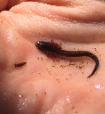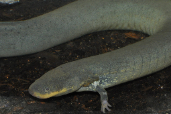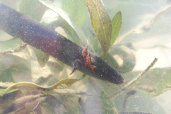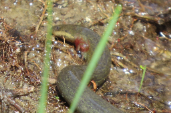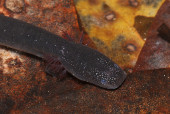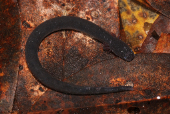|
Lesser Siren (Siren intermedia)
Description: Lesser sirens have elongated bodies possessing only two limbs, a pair of four-toed legs located behind the base of the head, and range in length from 7 to 27 inches. Unlike greater sirens, lesser sirens have less than 35 costal grooves. Juvenile specimens have red to yellow banding on their heads and stripes running along the main length of the body, although these stripes are absent in Siren intermedia. Adults have plainer coloration; the dorsal side is typically olive green to blue-gray or black, while the ventral is usually light grey. Spotted patterns may also be present in adults. In salamanders, sexual size dimorphism is usually female-biased, but in Siren intermedia, it’s the opposite. Males are the larger sex, and they also have significantly larger heads and enlarged masseter muscles than females. Lesser sirens are notably neotenic, and possess external gills throughout their lives.
Habitat: Sirens are likely to be found in ponds near other intermittent wetlands. They usually inhabit swamps and ponds, and can survive in dry ponds for up to two years by a process called “aestivating”. Sirens are considered poor overland dispersers because they rarely leave the water, so their geographical distribution is largely determined by pond connectivity and biotic interactions.
Range: The lesser siren is found in the United States and Mexico, primarily from Virginia to Florida, west to Texas, ranging into northeastern Mexico as far as Veracruz, and north to Illinois and southwest Michigan. Multiple specimens have recently been rediscovered in Michigan after a 60-year absence. Lesser sirens only occur in permanent wetlands, whereas other salamander and frog species can occupy a range of dry and wetlands. Lesser sirens are top predators in permanent wetlands. They can quickly colonize and become dominant consumers in new ponds such as those constructed by beavers. Their ability to aestivate and burrow in soft sediments and live in dense aquatic vegetation in shallow waters facilitates their dominance. In addition, the species’ high productivity, high fecundity, and rapid growth to early sexual maturity allows it reach a high density quickly and easily, and thus establish dominance in the habitat.
Diet: Though little is known about their courtship, it is believed to be quite violent, as many specimens collected have scarring from healed bite marks from other sirens. About 12-300 eggs are laid at a time, and several clutches may be laid over the course of the year. Hatchlings are only about 0.4 in (1.1 cm) in length, but grow quickly. Maturity is typically reached in approximately three to four years. Courtship includes several repeating behavioral patterns. Once the female approaches the nest site, the male and female start moving within the area, coiling around each other. The male pursues the female’s cloaca closely, sometimes rubbing his head against the flank and the cloacal region of the female. Both the male and the female wave their tail fins by undulating the tail tip.
Lesser sirens are filter feeders. They sift through pond bottoms and aquatic vegetation for prey items. They have heavily keratinized beaks and vomerine dental arrays that can inflict substantial wounds. The diet of the lesser siren includes at least 10 different taxa, which includes primarily aquatic invertebrates, including tadpoles and snails. They also eat several insects and their larvae, crayfish, mollusks, amphibians, siren eggs, and algae, although the plant material may be an incidental result of their gape-and-suck feeding style.
Reproduction: During oviposition, the female turns on its back, positions the cloaca near the top of the nest cavity and halts for several seconds. Then the male positions his cloaca near the site of oviposition. Eggs are directly coiled into the moss that the male has prepared in the nest. Interlacing of the eggs into the plant material in the nest ensures that the eggs adhere to the nest as a compact mass, and facilitates external fertilization.
In S. intermedia, parental care is fulfilled by the males. Paternal care as observed in the lesser siren is very rare for salamanders. After the female completes oviposition and leaves the nest, the male stays in close proximity to the eggs and takes the responsibility of parental care. The total number of eggs can be around 120–130, with a diameter of about 3 mm. The male constantly moves the egg mass, circles around it, and aerates the eggs through vigorous tail fanning. The tail-fanning behavior of the male towards the eggs can enhance sperm dispersal. Additionally, the male continuously cleans the nest from sand and other materials, to improve hygienic conditions and possibly to prevent infections from pathogens and fungi. It is also likely that males remove dead or infected eggs, in order to prevent further infection of the viable eggs.
The development of the larvae takes approximately 35 days. Paternal care does not end there however, it continues after the larvae hatch and the male continues to aggressively defend the larvae up to one week after hatching.
Status: Listed as Least Concern in view of its relatively wide distribution, tolerance of a degree of habitat modification and presumed large population.
Subspecies: Three, all found in the United States
Eastern Lesser - (Siren Siren intermedia intermedia)
Western Lesser - (Siren Siren intermedia nettingi)
Rio Grande Siren - (Siren intermedia texana)
Sources disagree on the number of subspecies within S. intermedia. The majority of the sources in the field agree there are at least two: an eastern and a western variety. Many sources also include a third subspecies, the Rio Grande lesser siren, S. i. texana, but researchers disagree whether the Rio Grande variety belongs as a lesser siren, within S. intermedia, or as a greater siren, within S. lacertina, and some others even consider it to be its own species, as S. texana.
Taxonomy: Siren intermedia will be split into Siren intermedia, Siren sphagnicola, and Siren nettingi. View Change Here..
»» Kingdom: Animalia - Animals
»» Phylum: Chordata - Chordates
»» Subphylum: Vertebrata - Vertebrates
»» Class: Amphibia - (Amphibians)
»» Order: Caudata - Salamanders
»» Family: Sirenidae - Sirens
»» Genus: Siren
»» Species: Siren intermedia - Lesser Siren
This article uses material from the Wikipedia article "Lesser Siren", which is released under the Creative Commons Attribution-Share-Alike License 3.0. Content may have been omitted from the original, but no content has been changed or extended.
|
|


